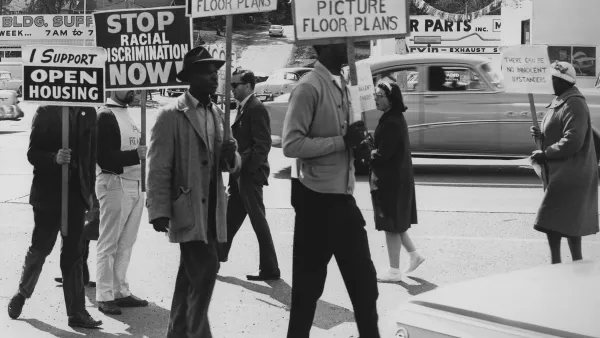Planopedia
Clear, accessible definitions for common urban planning terms.

Fair Housing Act
Signed in 1968, the Fair Housing Act legally prohibits discrimination on the basis of race, sex, and other protected categories in housing. Over fifty years later, access to safe and affordable housing remains uneven across social and racial groups.

The City of Tomorrow
The City of Tomorrow is the English name given to an early work of urban design by Le Corbusier, who, throughout his career, evolved a concept of city planning firmly based in rationality and order.

Green Infrastructure
Green infrastructure harnesses nature to the benefit of the built environment as well as human and animal life.

Transportation Demand Management
When a government creates incentives or disincentives to influence how and when you travel—that's transportation demand management.

Bus Rapid Transit (BRT)
Combining elements of rapid transit with buses, BRT systems can provide faster, more reliable service at lower cost than rail-based transit.

Easements
There are limits to the rights and powers associated with land ownership. Easements are a critical example of how property rights can be balanced with the needs of neighbors, the public, and other interests external to the control of property owners.

The Housing Choice Voucher Program
Federal housing assistance vouchers subsidize the cost of rental housing, but high demand and long waiting lists mean many low-income families wait for years to access affordable housing.

Rent Control
Rent control, also known as rent stabilization, is a controversial policy tool used by the government to limit rent increases by landlords.

Road Diet
A road diet ‘trims down’ multilane roadways by reallocating street space to uses other than car traffic, improving safety for pedestrians, encouraging multimodal travel, and enhancing overall livability.

15-Minute City
The buzzword recently popularized by urbanists describes an urban form that dominated cities prior to the rise of autocentric planning.

Defensive Urbanism
If you’ve ever noticed a public bench split in half by a metal bar, or a series of seemingly ornamental boulders blocking the sidewalk under a high-rise overhang, you’ve seen what is often described as defensive urbanism or ‘hostile architecture.’

Bike Infrastructure
Safe and comprehensive bike facilities play a crucial role in keeping vulnerable road users safe, promoting biking as an everyday transit mode, and reducing carbon emissions and traffic congestion by encouraging a shift to more multimodal transportation.

Clean Water Act
The primary environmental law to regulate water pollution in the United States, the Clean Water Act, went into effect 50 years ago, on October 18, 1972.

Woonerf
The woonerf, a type of road design that encourages multimodal transportation and blends pedestrian and vehicle space, was born as a reaction to the car-centric development that began dominating American and European city planning in the mid-twentieth century.

Variances
Variances allow for development projects to deviate from the zoning code on a case-by-case basis—if the project developer can prove a unique economic or physical hardship.

Zoning Amendments
Zoning amendments change the existing zoning code by either of two methods: changing the text of the zoning code or changing the zoning map.

Traffic Calming
Traffic calming is a set of design interventions aimed at slowing or diverting car traffic to reduce the chance of crashes and improve safety for all road users.

Urban Heat Island Effect
Man-made surfaces and urban density contribute to higher temperatures, intensifying heat waves and posing a growing danger to public health.

Transect
In urbanism and planning, the term transect provides a conceptual framework for understanding how the scale of built environments can vary from place to place.

Geographic Information Systems
GIS software, which combines location information with data about a range of other attributes, has become an indispensable tool for mapping and spatial analysis in urban planning and dozens of other fields.

Redevelopment
Redevelopment includes all development projects that build new structures and land uses on a previously developed site. Understanding the nuances of redevelopment is critical for understanding the ways cities and communities change.

Non-Conforming Uses
A non-conforming use is an existing building that would not be built under current land use regulations. While esoteric, the term is nonetheless critical to understanding the changes in development regulations over time.

Land Bank
Land banks are public or private organizations that purchase, hold, redevelop, or otherwise manage foreclosed or abandoned properties with the goal of achieving community objectives such as affordable housing construction or public park space.

YIMBYs
YIMBY, an acronym standing for "Yes In My Backyard," describes advocates who support housing development as a response to the outcomes of restrictive zoning and planning policies.

Tactical Urbanism
Tactical urbanism, one of the most common buzzwords in planning over the past decade, describes a variety of low-cost, incremental public realm design interventions.

Overlay Districts
A zoning overlay district superimposes an additional set of regulations over an existing zoning district, or multiple zoning districts.

Induced Demand
“If you build it, they will come.”

Incremental Planning
The concept of incrementalism can be applied to numerous fields and disciplines—one of which is planning. In the field of planning, the word incremental is usually used as an adjective to describe other planning words, such as code reform and development.

Planning Commissions
Planning commissions fill an influential advisory role in planning processes, maintaining citizen oversight of government planning powers and also providing a public forum for debate about the future of communities.

Supportive Housing
Supportive housing combines affordable housing with social services providers to help people experiencing homelessness, disability, or other hardships transition to permanent housing.
Pagination
Urban Design for Planners 1: Software Tools
This six-course series explores essential urban design concepts using open source software and equips planners with the tools they need to participate fully in the urban design process.
Planning for Universal Design
Learn the tools for implementing Universal Design in planning regulations.
planning NEXT
Appalachian Highlands Housing Partners
Mpact (founded as Rail~Volution)
City of Camden Redevelopment Agency
City of Astoria
City of Portland
City of Laramie

























